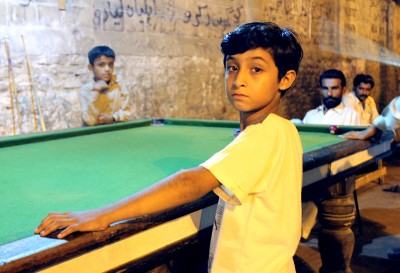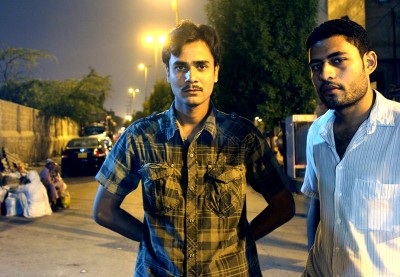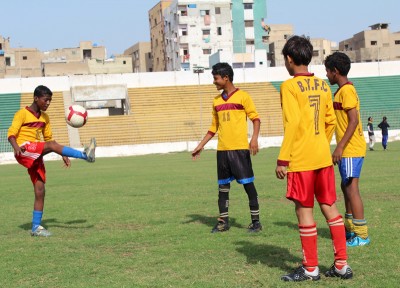
Lyari is the most notorious neighborhood in Pakistan’s largest and most chaotic city. But just like in poor urban areas in the US, young residents are looking toward sports as a way to escape from the violence and turn their neighborhood’s reputation around.
Faris Kasim reports from Karachi on the real story behind Lyari’s bad boy image, and the change residents want to see.
Karachi is one of the most dangerous places in the world.
At least that’s the bad rap it has.
Sitting in the metropolitan heart of Pakistan, this city has suffered from terrorist attacks and regular spates of ethnic, sectarian and political violence.

Most of this is centered in Lyari, a 4-square mile neighborhood bursting with over a million people. (To put that into perspective, you’d have to multiply the population of Seattle’s Capitol Hill neighborhood by 25 to come close to the density of Lyari.)
The news from the area is often of a bomb blast, a riot, clash between rival political groups or the daily tally of people killed.
But not all is what it seems in this corner of Pakistan. Mohammad Asghar, a government school teacher, said his neighborhood is often unfairly reported about.
“It is absolutely wrong to label Karachi and Lyari as the center of crime,” Asghar said.
Asghar is one of a growing number of Lyari residents who want to shake the perception that his city is a just a hideout for gangsters and criminals, but home to vibrant athletics programs and strong community support.
In the 1950s, Karachi morphed into a booming economic hub after gaining independence from the British. But Lyari sat on the outskirts of the developments, disenfranchised and neglected.

And now, Lyari is often referenced in the larger narrative of political and religious violence in Karachi and highlighted as the epicentre of crime.
In 2012, more than 1,000 people have already lost their lives to violence in Karachi, with 109 in the month of July alone.
The city hit a peak last summer when 300 of the city’s residents were killed in an explosion of ongoing violence.
“Like other areas of Karachi, there are gangs and criminal elements here,” Asghar said. “But why are we branded as sole culprits for Karachi’s violence?”
Police operations – heavy contingents of armed men deployed for a certain number of days – are often conducted to flush out these elements and “control” the gangs.
But this is just one side of the picture.
The Real Lyari
Shahbaz Jan, 28, works with the Karachi Port Authority. He’s from a middle class family and is well educated, but he has still suffered through Lyari’s turmoil since he was a child.

“I witnessed snatching and gunfights as a boy,” Jan said. “Because of their actions, we now believe that rather than protecting citizens, the police are a foreign, armed group bent on killing us.”
Jan’s sentiments resound with the majority of Lyari’s population. They feel discriminated against and say they’re all labelled as collaborators or supporters of gangsters in their area.
“When I miss work because the police had cordoned off main roads and public transport was unavailable, people in my office are unsympathetic,” Jan said.
Asghar explained how young men have difficulty breaking out of poverty or stereotypes expected of them in Lyari.
“Young boys belonging to (poor) families are expected to contribute to the family’s income as soon as they turn 16,” Asghar said. “In a cutthroat competitive place like Karachi, these boys are at the very bottom of the social ladder and are lucky to find positions as office boys or doormen.”
These young men are often easy recruits for gangs offering a handsome salary with power and respect.

I talked with Jan at Cheel Chowk, an intersection with an obelisk hoisting a large metallic eagle.
This was the center of the recent police operation, with nearby streets barricaded for days with burnt out cars and debris of surrounding houses. The intense firefights were broadcasted live on TV channels.
“Majority of the people who suffered in the operation were innocent,” Jan said pointing to the street which resembled a battlefield two months ago. “What’s most disturbing is like all previous operations, this one also did not yield any results either. No gangster was caught, no criminal eliminated.”
Asghar says these images do not reflect the Lyari he knows and sees everyday.
“Why don’t they show the streets full of children playing, football and cricket tournaments and gyms and boxing clubs teeming with both young and old, even in holy month of Ramadan?” Asghar asks.
Football: Lyari’s secret weapon

It is easy to understand Asghar and Jan’s frustration.
Walking through Lyari, one feels a natural vibrancy on the streets.
Sports are an integral part of life here and are the only option for youth who don’t excel in academics.
Compared to the vast geographical expanse of Pakistan, this small area produces a large majority of the country’s footballers, boxers, cyclists and gymnasts.
These athletes include Hussain Shah, Pakistan’s first boxer to win a medal at the Olympics.
Shahzeb Gul, 13, is a member of the Under 14 football division in Karachi and dreams of becoming a professional athlete.
“Football is my life,” Shahzeb said. “Other than school this is the only activity I have to look forward to.”
Although national level players do not earn as much as professional cricket and field hockey players, they fare much better than most other professions open to them in Lyari.
“The dream of children here is to excel in sports and make a living through it,” Shahzeb said. “There is much fighting in our area and I have seen people getting killed. My parents and brothers always advise me to stay clear of places where the gangs are active. We do not step out of home during police operations.”
Even in the ever-increasing violence of Lyari and the rest of Karachi, children such as Shahzeb have high hopes of attaining permanent public sector jobs by being selected as a football player in their various departmental teams.
“My father and uncle are both football players and I want to follow in their footsteps,” Shahzeb said.
A neighborhood of resilience
In spite of all the hardships faced, the people of Lyari are a resilient lot.
Whether they are labelled as criminals or suffer the violence from both gangsters and police, they are unwilling to leave their homes.
“People are very positive here,” Shahbaz smiled. “Ordinary people are struggling to improve their lives and the youth are motivated to change things around. Education is a priority for all families.”
Asghar concluded, “No matter what the world throws us at, we are very hopeful because we know that there is light at the end of the tunnel.”


LOL Karachi is a filthy trainwreck of a city. It’s amazing the Lyari is reknowned for being even more corrupt and dangerous! Why are these people so violent, dysfunctional and amoral? Is it their religion? It it their upbringing?